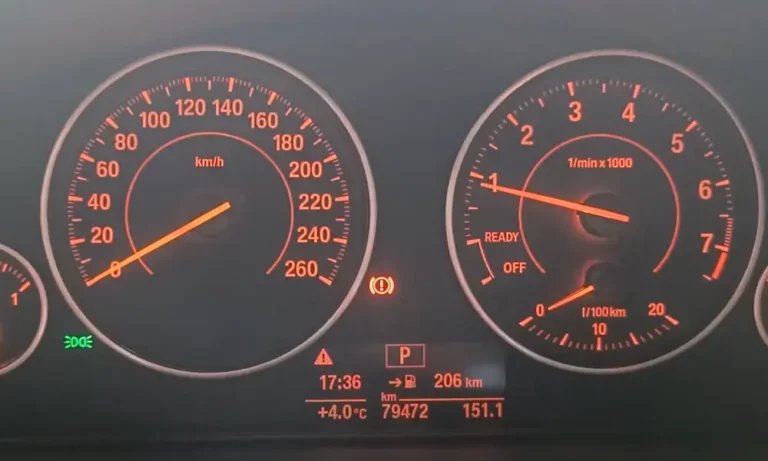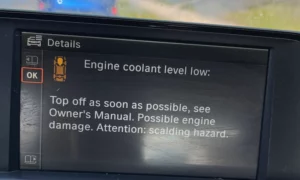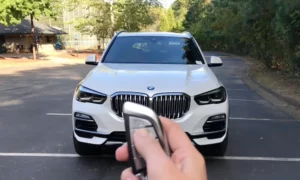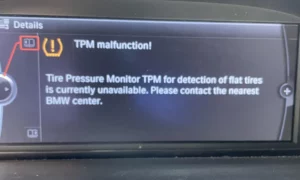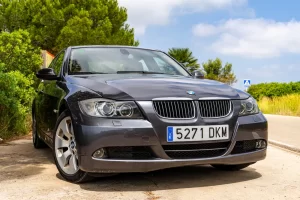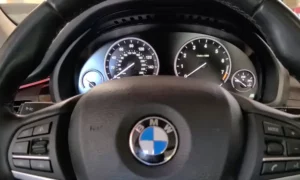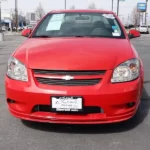That mysterious yellow triangle with an exclamation mark lighting up your BMW dashboard can be confusing. Is it serious? Can you keep driving? What’s it trying to tell you?
If you’ve found yourself staring at this warning light wondering what to do next, you’re in the right place. This guide breaks down everything you need to know about this common BMW warning symbol, from what triggers it to how you can diagnose and fix the problems yourself.
What Does the BMW Triangle Warning Light Mean?
The exclamation mark inside a triangle on your BMW dashboard is part of the vehicle’s Check Control system. It’s a general warning indicator that acts like a messenger telling you “Hey, something needs your attention.”
Unlike specific warning lights (like the engine or oil symbols), this triangle doesn’t pinpoint the exact issue. Instead, it’s alerting you that there’s a message stored in your car’s computer that you need to check.
BMW uses a color-coded system for all dashboard warnings:
- Red lights indicate serious problems requiring immediate attention
- Yellow/orange lights (including the triangle) signal issues that need addressing soon
- Green and blue lights are simply informational
The triangle warning typically falls in the yellow/orange category, meaning it’s important but not necessarily an emergency that requires pulling over immediately.
Most Common Causes of the Triangle Warning Light
Low Fuel Level
One of the most frequent triggers is simply running low on fuel. Your BMW will typically activate this warning when you have approximately 50 miles of range remaining. This gives you plenty of time to find a gas station before you’re completely empty.
The fix is simple: fill up your tank. Once you’ve refueled, the warning should disappear automatically or after restarting your vehicle.
Tire Pressure Issues
The Tire Pressure Monitoring System (TPMS) is another common trigger for the triangle warning. Your BMW constantly monitors the pressure in all four tires, and when one or more tires have incorrect pressure (too high or too low), the warning appears.
To fix this:
- Check all tire pressures using a gauge
- Inflate or deflate tires to the recommended PSI (found inside your driver’s door jamb)
- Reset the TPMS through your iDrive system (Vehicle Status > Tire Pressure)
Open Doors, Hood, or Trunk
Your BMW will display the triangle warning if any door, the hood, or the trunk isn’t properly closed. This is a safety feature to prevent driving with unsecured compartments.
Simply check all doors, hood, and trunk to make sure they’re fully closed and latched. The warning should disappear once everything is properly secured.
Unfastened Seatbelts
Safety first! If the driver or front passenger isn’t wearing a seatbelt, your BMW will activate the triangle warning along with a seatbelt reminder icon.
Fastening all occupied seatbelts will clear this warning.
Low Fluid Levels
Beyond fuel, your BMW monitors several other fluid levels that can trigger the triangle warning:
- Windshield washer fluid
- Coolant level
- Diesel exhaust fluid (DEF) in diesel models
Checking and topping up the appropriate fluid will typically resolve the warning.
How to Access Your BMW’s Warning Messages
When you see the exclamation mark in the triangle, your BMW has stored specific information about what triggered it. Here’s how to access those details:
For BMW Models with iDrive:
- Press the “Menu” or “Car” button on your iDrive controller
- Select “Vehicle Status” or “Vehicle Information”
- Choose “Check Control Messages”
- Review any active warnings
For BMW Models Without iDrive:
- Press the BC (Board Computer) button on your turn signal stalk
- Use the scroll wheel to navigate through stored messages
- Each message will display briefly with details about the issue
The specific message will tell you exactly what’s triggered the triangle warning and often provides guidance on what action to take.
Diagnostic Tools for More Complex Issues
If you’ve checked the basic causes and still can’t resolve the triangle warning, it’s time to dig deeper with diagnostic tools.
Using OBD-II Scanners
An OBD-II scanner can retrieve fault codes from your BMW’s computer systems. These codes provide specific information about what’s malfunctioning.
Basic OBD-II scanners start around $30 and connect to your car’s diagnostic port (usually located under the dashboard near the steering wheel). Many can link to smartphone apps that translate cryptic codes into plain English.
For BMW-specific issues, you might need a more specialized scanner. Tools that can access BMW-specific systems include:
- Foxwell NT510 Elite
- Autel MaxiSys
- Carly for BMW
These specialized tools can access more systems beyond just the engine computer.
My BMW App and Digital Services
The official My BMW app connects to your vehicle and can provide detailed information about warning lights and maintenance needs. After setting up your account with your VIN number, you can:
- Check vehicle status remotely
- View warning details
- Schedule service appointments
- Access your digital owner’s manual
This digital connection offers a convenient way to diagnose issues without special tools.
When Should You Be Concerned?
Not all triangle warnings require immediate action. Here’s a simple guide to help you decide how urgently you need to address the warning:
Safe to Continue Driving (Usually):
- Low fuel warning
- Windshield washer fluid reminder
- Door ajar notification
- Unfastened seatbelt warning
- Minor tire pressure deviations
Requires Prompt Attention (Within Days):
- Significant tire pressure issues
- Low coolant level
- Battery/charging system warnings
- Burned-out exterior lights
- Service due reminders
Stop Driving Immediately:
- Red triangle warnings (especially if flashing)
- Triangle accompanied by engine overheating warning
- Triangle with brake system warnings
- Multiple warning lights illuminated simultaneously
- Any warning with noticeable performance problems
When in doubt, it’s always better to err on the side of caution. Pull over safely if you notice any unusual sounds, smells, or changes in how your BMW drives.
How to Reset the Triangle Warning Light
After addressing the underlying issue, you’ll usually want to clear the warning light. Here’s how:
Automatic Reset
Many warnings will reset automatically after you’ve fixed the problem. For example, after refueling or properly closing all doors, the warning should disappear on its own or after restarting the vehicle.
Manual Reset via iDrive
- Navigate to “Vehicle Status” > “Check Control Messages”
- Select the resolved warning
- Press and hold the iDrive controller or select “Clear” or “Reset”
Manual Reset via BC Button
- Access the warning message using the BC button
- When viewing the message you want to clear, press and hold the BC button for about 5 seconds
Battery Disconnect (Last Resort)
If other methods fail, disconnecting your vehicle’s battery for 15-30 minutes may reset the warning system. However, this will also reset other systems and should only be done as a last resort.
Table: BMW Triangle Warning Causes and Solutions
| Common Cause | Symptoms | DIY Solution | Professional Help Needed? |
|---|---|---|---|
| Low Fuel | Triangle with ~50 miles range remaining | Refill fuel tank | No |
| Tire Pressure | Triangle with possible TPMS icon | Check all tires, inflate to correct PSI, reset TPMS | Only if tires have damage |
| Open Door/Trunk | Triangle with graphic showing which door is open | Close all doors securely | No |
| Low Fluids | Triangle with specific fluid indicator | Check and top up appropriate fluid | Only if leaks are present |
| Seatbelt Reminder | Triangle with seatbelt icon | Fasten all occupied seatbelts | No |
| Lighting Issue | Triangle with bulb icon | Check and replace any burned-out bulbs | Possibly for adaptive headlights |
| Engine/Emissions | Triangle with engine icon | Check engine oil, scan for codes | Yes, if check engine light is also on |
Table: BMW Warning Light Color Guide
| Color | Urgency | Example Warnings | Recommended Action |
|---|---|---|---|
| Red | Critical | Brake failure, overheating, oil pressure | Stop immediately and seek help |
| Yellow/Orange | Caution | Triangle warning, ABS, tire pressure | Investigate soon but typically safe to continue driving |
| Green | Informational | Turn signals, high beams | No action needed |
| Blue | Informational | Headlights, high beams active | No action needed |
Preventing Future Triangle Warnings
The best way to deal with warning lights is to prevent them from appearing in the first place. Here’s how to minimize those annoying triangle warnings:
Regular Maintenance
Following BMW’s recommended maintenance schedule helps prevent many issues that trigger warnings. This includes:
- Regular oil changes
- Fluid checks and top-offs
- Tire rotations and pressure checks
- Battery testing
Addressing Issues Promptly
Don’t ignore small problems that could develop into bigger ones. When your BMW first displays a minor warning, addressing it quickly can prevent cascading issues.
Proper Driving Habits
Some warning lights are triggered by how you drive:
- Don’t let your fuel level get too low
- Ensure doors and trunks are fully closed before driving
- Always wear seatbelts
- Allow the car to warm up in cold weather
Use Quality Parts and Fluids
BMW engines and systems are designed with specific tolerances. Using the correct parts and fluids recommended by BMW helps prevent warning lights and ensures optimal performance.
Understanding Your BMW’s Warning System
The triangle warning system in BMWs is designed with a philosophy of simplicity and information hierarchy. Rather than cluttering your dashboard with dozens of specific icons, BMW uses the triangle as a general alert that prompts you to check for more details.
This system works well once you understand it, but can be confusing for new BMW owners. Think of the triangle warning as your car’s way of saying “I need to tell you something” rather than “There’s an emergency.”
Most modern BMWs have multiple computers that monitor everything from engine performance to door switches. The central vehicle computer system collects this information and decides when to alert you with the triangle warning.
As BMWs become more advanced, the number of systems being monitored increases, which is why newer models might display the triangle warning for issues that older BMWs wouldn’t detect.
Real-World Examples of BMW Triangle Warnings
Case Study 1: Intermittent Headlight Issues
A 2014 BMW 428i owner experienced a triangle warning that would appear and disappear randomly. There were no obvious problems with the vehicle’s performance. After checking the stored messages, they discovered an intermittent adaptive headlight malfunction. A BMW software update resolved the issue completely.
Case Study 2: Cold Weather False Alarms
Many BMW owners in colder climates report triangle warnings appearing overnight when temperatures drop significantly. This is almost always related to tire pressure decreases caused by cold air. The solution is simple: allow the tires to warm up during driving, check pressures when warm, and reset the TPMS system if needed.
Case Study 3: Post-Refueling Warning
A diesel BMW owner found that the triangle warning would appear shortly after refueling. Diagnostic scanning revealed a faulty sensor in the diesel particulate filter system that was triggered by the refueling process. A sensor replacement was required to resolve this more complex issue.
BMW Triangle Warning Light and Modern Tech Features
In newer BMW models with advanced driver assistance systems, the triangle warning may also indicate issues with:
- Adaptive cruise control sensors
- Lane departure warning cameras
- Parking assistance systems
- Collision warning sensors
- Rain sensing wipers
When these sophisticated systems detect a problem or become temporarily unavailable (such as when snow covers a sensor), they’ll trigger the triangle warning with a specific message.
Most of these advanced system warnings are informational rather than indicating mechanical problems. Cleaning sensors or waiting for improved weather conditions often resolves these warnings without any mechanical intervention.
The National Highway Traffic Safety Administration recommends familiarizing yourself with all warning indicators in your vehicle to promote safer driving and proper vehicle maintenance.
Understanding your BMW’s warning systems helps you make informed decisions about when service is required and when a warning can be safely addressed at your convenience. The triangle warning is designed to keep you informed about your vehicle’s status without creating unnecessary panic.
In most cases, the BMW exclamation mark in triangle warning is more of a “heads up” than a crisis. Taking a methodical approach to diagnosing and addressing the underlying cause will keep your BMW running smoothly and your dashboard free of warning lights.

